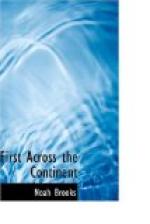Two days later, the journal records that one of the party killed a grizzly bear, “which, though shot through the heart, ran at his usual pace nearly a quarter of a mile before he fell.”
The mouth of the Musselshell River, which was one of the notable points that marked another stage in the journey, was reached on the twentieth of May. This stream empties into the Missouri two thousand two hundred and seventy miles above its mouth, and is still known by the name given it by its discoverers. The journal says:
“It is one hundred and ten yards wide, and contains more water than streams of that size usually do in this country; its current is by no means rapid, and there is every appearance of its being susceptible of navigation by canoes for a considerable distance. Its bed is chiefly formed of coarse sand and gravel, with an occasional mixture of black mud; the banks are abrupt and nearly twelve feet high, so that they are secure from being overflowed; the water is of a greenish-yellow cast, and much more transparent than that of the Missouri, which itself, though clearer than below, still retains its whitish hue and a portion of its sediment. Opposite the point of junction the current of the Missouri is gentle, and two hundred and twenty-two yards in width; the bed is principally of mud, the little sand remaining being wholly confined to the points, and the water is still too deep to use the setting-pole.
“If this be, as we suppose, the Musselshell, our Indian information is that it rises in the first chain of the Rocky mountains not far from the sources of the Yellowstone, whence in its course to this place it waters a high broken country, well timbered, particularly on its borders, and interspersed with handsome fertile plains and meadows. We have reason, however, to believe, from their giving a similar account of the timber where we now are, that the timber of which they speak is similar to that which we have seen for a few days past, which consists of nothing more than a few straggling small pines and dwarf cedars on the summits of the hills, nine-tenths of the ground being totally destitute of wood, and covered with short grass, aromatic herbs, and an immense quantity of prickly-pear; though the party who explored it for eight miles represented the low grounds on the river to be well supplied with cottonwood of a tolerable size, and of an excellent soil. They also report that the country is broken and irregular, like that near our camp; and that about five miles up, a handsome river, about fifty yards wide, which we named after Chaboneau’s wife, Sacajawea’s or the Bird-woman’s River, discharges into the Musselshell on the north or upper side.”
Later explorations have shown that the Musselshell rises in the Little Belt Mountains, considerably to the north of the sources of the Yellowstone. Modern geography has also taken from the good Sacajawea the honor of having her name bestowed on one of the branches of the Musselshell. The stream once named for her is now known as Crooked Creek: it joins the river near its mouth, in the central portion of Montana. The journal, under date of May 22, has this entry:—




